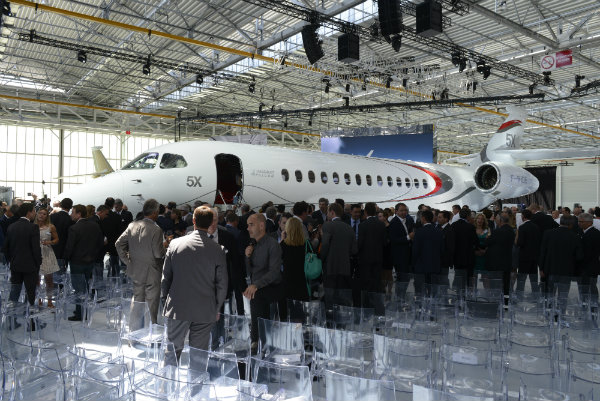Dassault rolled out its Falcon 5X on 2 June at a dedicated ceremony at its 64-year-old final assembly facility at Bordeaux-Mérignac airport in southwest France.
In front of a specially selected audience of customers, operators, suppliers and regulators, Dassault Aviation chairman and chief executive Eric Trappier declared that the large-cabin, long-range aircraft was not only a “game changer” in this niche and nascent sector but also marked the first of a family of new-generation wide-cabin business jets from the French airframer.
“Cabin width is an integral part of our product line strategy going forward,” Trappier says.
With a fuselage diameter of 2.7m (8.9ft) and a cabin height of 1.98m, the 16-passenger 5X is the largest aircraft in Dassault’s six-strong high-end business jet family and boasts the widest cabin cross section of any traditional business jet.
The future Falcon family, Trappier says, is likely to include a stretched and longer-range version of the 5X, which will compete at the top end of the market with the ultra-long-range Gulfstream G650 and in-development Global 7000 and 8000. He refuses to be drawn, however, on specific timeline for the launch of this new offering.
“All new programmes, whatever they will be, will have the wider cabin [as standard],” Trappier adds. “However, for now, our priority is to focus on bringing the 5X and 8X to market over the next two years.” The trijet – a longer legged and stretched version of the long-range 7X, with a range of 6,450nm (12,000km) – was unveiled in December and is scheduled to enter service next year.
“Once we are in an advanced stage of development [with these programmes], we can release our engineers and designers to work on new projects,” Trappier adds.
The 5X was unveiled at the National Business Aviation Association convention and exhibition in October 2013, and is the French airframer’s first clean-sheet design since the 7X was unveiled in 2001.
The 5X was originally conceived as a super-midsize business jet – dubbed the Falcon SMS. But following extensive market research and feedback from its “highly valued” customer advisory board, Dassault elected to position this latest design in the nascent large-cabin, long-range sector.

BillyPix
“We didn’t want an aircraft in the $20-35 million business jet segment as we felt it would compete with the Falcon 2000LX/S – already a best-selling aircraft in the super-midsize/large cabin-market and with a long-term future in the Falcon family,” says Dassault Falcon Jet president and chief executive John Rosanvallon. “The market was also moving towards larger-cabin offerings, so that is where we decided to focus.” he adds.
The $45 million 5X fills a gap in Dassault’s six-strong product line between the large-cabin Falcon 900LX and the 7X trijets and is pitched against the Bombardier Global 5000, Gulfstream G450 and in-development G500 and G600.
The aircraft is powered by two 11,450lb (51kN)-thrust Snecma Silvercrest engines, marking the first time a Falcon has been launched with an all-new powerplant, or one produced by a French manufacturer.
The type is projected to have a maximum speed of 370kt (685km/h), a maximum take-off weight of 31,600kg (69,700lb), a range of 5,200nm and an approach speed of 105kt.
Other new features include the latest iteration of Dassault’s EASy flightdeck with Elbit head-up display, an ultra-efficient wing, an advanced digital flight control system derived from the Rafale fighter and a unique window in the ceiling of the cabin giving a direct view of the sky above.
To help enhance the pilot’s visibility on visual approaches, Dassault has made the 5X cockpit windows around 30% larger than those of other Falcons
Aerospace analyst Rolland Vincent is confident that Dassault has found a winning formula with the 5X and believes the Mach 0.90 aircraft will help reinvigorate the large-cabin business jet sector, which he says is recovering from a 30% decline in annual deliveries from the 2008-2009 peak to trough in 2011. Vincent predicts new deliveries of around 500 large-cabin, long-range aircraft between 2016-2020, up about 5% over the prior period. “With Global 5000 production rates being cut back in 2016 and beyond, this will create additional market space for the 5X,” he says.
The aircraft has already been greeted “enthusiastically”, Trappier says, by existing customers and buyers who are new to business aviation. Company patriarch Serge Dassault will be the recipient of one of the early models, he adds.
“We have a healthy orderbook for the 5X from across the globe,” agrees Dassault regional sales and marketing director Renaud Cloatre, although he will not be drawn on exact sales numbers. “The aircraft’s huge cabin, coupled with its intercontinental range is very appealing. For example, it can connect the Middle East with all of Africa and Europe and can fly six passengers for 11h, ” he adds. Like its Falcon stablemates – the 5X will also be certificated for steep approach allowing it to take off and land from some of the world’s most challenging hubs, including London City airport in the UK.
Aircraft serial number one is scheduled to take flight in the third quarter and will be used to open the flight envelope. Three aircraft will take part in the certification campaign, with entry into service targeted for late 2017/early 2018.
Source: Flight International



















